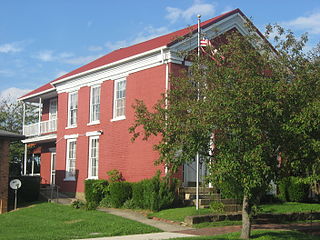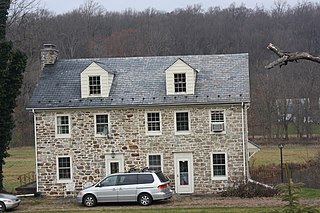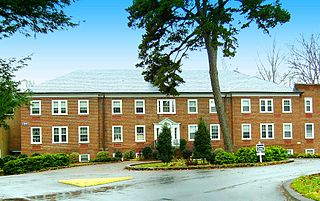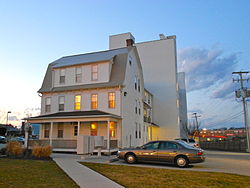
The McKinley School, also known as North Side School, is a historic school building located at Seventeenth St. and Home Ave., in Columbus, Indiana. It was designed by architect Charles Franklin Sparrell and built in 1892. It is a 2 1/2-story, five bay, Richardsonian Romanesque style red brick building with a limestone base and hipped roof. It measures 73 feet wide and 38 feet deep. An addition was erected in 1942, and measures approximately 127 feet wide and 38 feet deep.

Benjamin Church House is a Colonial Revival house at 1014 Hope Street in Bristol, Rhode Island, U.S.A. It opened in 1909 as the "Benjamin Church Home for Aged Men" as stipulated by Benjamin Church's will. Beginning in 1934, during the Great Depression, it admitted women. The house was closed in 1968 and became a National Register of Historic Places listing in 1971. The non-profit Benjamin Church Senior Center was incorporated in June 1972 and opened on September 1, 1972. It continues to operate as a senior center.

The Ashland Town House is the current town hall of Ashland, Massachusetts. It is located at 101 Main Street, in the town center. The 2-1/2 story wood frame building was built in 1855, and has been used continuously for municipal purposes since then. It is a fine local example of Greek Revival architecture, with some Italianate and Colonial Revival details. The building was listed on the National Register of Historic Places in 2004.

The Jacob Ten Broeck Stone House is located on Albany Avenue in Kingston, New York, United States. It is a stone house built in the early years of the 19th century and modified later in that century.

Immaculate Conception Catholic Church is a parish of the Roman Catholic Church in Celina, Ohio, United States. Founded later than many other Catholic parishes in the heavily Catholic region of western Ohio, it owns a complex of buildings constructed in the early 20th century that have been designated historic sites because of their architecture. Leading among them is its massive church, built in the Romanesque Revival style just 43 years after the first Catholic moved into the city: it has been called northwestern Ohio's grandest church building.

Elizabeth Kunkel House is a historic home located near Martinsburg, Berkeley County, West Virginia. It was built in 1907 and is a two-story, "L"-shaped, Late Victorian Gothic-style wood frame dwelling. It measures 40 feet wide and 50 feet deep, with a gable roof, and sits on a stone foundation. It features two steeply pitched Gothic dormers. Also on the property are an early-20th century frame smokehouse and storage building.

Jacob VanDoren House, also known as "Allen Dale," is a historic home located near Martinsburg, Berkeley County, West Virginia. It was built between 1830 and 1836, and is a 2 1/2 story, stucco coated stone house in the Greek Revival style. It has a hip roof with balustraded deck and measures 49 feet wide by 44 feet deep. It features a one-story, one bay, entrance porch with a hip roof supported by Ionic order columns.

Z. D. Ramsdell House, also known as The Ramsdell House, is a historic home located at Ceredo, Wayne County, West Virginia, atop a mound claimed to be an Indian burial mound. It was built in 1857–1858, and is a two-story red brick and frame dwelling measuring 30 feet wide and 48 feet deep. It sits on a stone foundation and is in the Greek Revival-style with a gable roof. Zophar D. Ramsdell came to Ceredo at the invitation of the town's founder, and fellow abolitionist, Eli Thayer. He built a shoe and boot factory, served as a Captain and Quartermaster during the American Civil War, served as a postmaster after the war, and served as a legislative representative in the West Virginia State Senate during 1868 and 1869. The home is believed to be one of the last stops of The Underground Railroad before crossing the Ohio River to freedom. It is open as a historic house museum.

The Redden Forest Complex is located in Redden State Forest, Sussex County, Delaware. Now known as the Redden Forest Education Center, the complex includes three Shingle style buildings built in 1900-1902 as a hunting retreat for Pennsylvania Railroad heir Frank Graham Thompson. The complex was served by a specially built railroad siding in Redden Crossroads. The camp fell into disuse during the Great Depression and was acquired by the state of Delaware in the 1930s. It saw use by the Civilian Conservation Corps, then the complex and the surrounding property were designated Redden State Forest in 1937.

Jacob Funk House and Barn is a historic home located at Springfield Township, Bucks County, Pennsylvania. The house consists of three sections; the oldest built about 1792. It is a 2 1/2-story, stone dwelling measuring 40 feet wide and 28 feet deep and originally reflective of the Georgian style. The oldest section is a two-story, two bay, stone structure two rooms deep. About 1855, a two-story, three-bay extension was added to the east gable. A kitchen and bath addition was built about 1930. The house was remodeled in the Colonial Revival style between about 1945 and 1955, at which time a one-story addition and deck were added to the rear of the house. Also on the property are a contributing stone bank barn and stone spring house.

Mayfield, also known as the William Wilson House, is a historic home located near Middletown, New Castle County, Delaware. It was built about 1839, and is a 2 1/2-story, five bay, center hall plan brick dwelling with a two-story, rear service wing. The house is in a vernacular Greek Revival style. It measures approximately 45 feet wide and 25 feet deep. It features a steeply pitched gable roof with dormers and tetrastyle, Greek-Revival style porch on brick footings.

Windsor, also known as Annondale, is a historic home located near Port Penn, New Castle County, Delaware. It was built about 1760, and is a two-story, five-bay, gable-roof, brick building with interior brick chimneys at each gable end. It has a center-passage plan with overall dimensions of 45 feet wide by 19 feet deep. A two-story, wood-frame kitchen wing abuts the rear of the main house. The front facade features a hipped-roof frame porch added in the late-19th century. It is in the Federal style.

Professional Building, also known as the American Bank and Trust Company building, is a historic commercial building located at Suffolk, Virginia. It was built between 1916 and 1919, and is a seven-story, steel frame building with Pyrobar fireproofing. The building measures 35.2 feet wide by 81 feet deep. It is 80 feet tall and has Colonial Revival style architectural details.

Hugh Chatham Memorial Hospital is a historic hospital building located near Elkin, Surry County, North Carolina. The original rectangular section was built in 1930–1931, with additions made in 1937, 1947, and 1952. The original brick section is two stories over a partially above-ground basement in the Colonial Revival style/ It is eleven bays long and two rooms deep, with a slate-covered hipped roof with a central cupola and two rear dormers. The associated Nurses' Home was built in 1932, and is a two-story-with-basement rectangular brick building in the Colonial Revival style. Frame side wings were added to Nurses' Home in 1937. The hospital was converted to a nursing home and interior remodeled in 1973.

Moses Rountree House is a historic home located at Wilson, Wilson County, North Carolina. It was built about 1869, and is a two-story, three bays wide by two bays deep, Gothic Revival style frame house. It has a two-story rear ell. It has a steep gable roof and is sheathed in weatherboard. The house was moved in 1890 and about 1920, and was renovated in the 1930s adding Colonial Revival style design elements.

Martinsville Sanitarium is a historic mineral water sanitarium located at Martinsville, Morgan County, Indiana. It was built in 1925–1926, and is a 2 1⁄2-story, "oriental brick" and limestone building with an eclectic combination of Tudor Revival, Colonial Revival, Renaissance Revival, and Bungalow/American Craftsman style design elements. The main section measures 160 feet by 55 feet and has two projecting wings. It is topped by a cross-gabled hipped roof and features a sun porch, half-timbered gables, and overhanging eaves. The building faces the Martinsville Vandalia Depot.

Gustave Greystone-Meissner House, also known as Greystone and Evergreen Hill, is a historic home and national historic district located near Pevely, Jefferson County, Missouri. Greystone was built about 1845, and is a two-story, asymmetrical plan, Gothic Revival style frame dwelling. It sits on a limestone block foundation and measures 48 feet, 1 1/2 inches, wide and 39 feet, 1 inch deep. It has a steeply pitched gable roof with dormers and features Carpenter Gothic wood cut-work, finials and drops. Also on the property is the contributing Gustave Meissner House. It was built in 1875, and is 1 1/2-story, "L"-shaped, frame dwelling with a steeply pitched cross-gable roof.

Park Hill, also known as the Young-Faulkner House or Faulkner's Park Hill, is a 2 1⁄2-story Colonial Revival residence built in the late 1890s in Lincoln, Nebraska. Park Hill is listed in the National Register of Historic Places, and is significant for its architectural features—including the house, a garage, and a bridge—as well as its landscape, nearly three and a half acres of land bordered by thick, mature plantings of trees.

The Reuben Curtiss House is a historic house at 1770 Bucks Hill Road in Southbury, Connecticut. With a construction and alteration history dating from the late 18th to 20th centuries, the house is one of Southbury's finest examples of residential Greek Revival architecture. It was listed on the National Register of Historic Places in 1993.

The Booth-Dunham Estate is a single-family home located at 6059 South Ninth Street Texas Charter Township near Kalamazoo, Michigan. It was listed on the National Register of Historic Places in 1998.
























